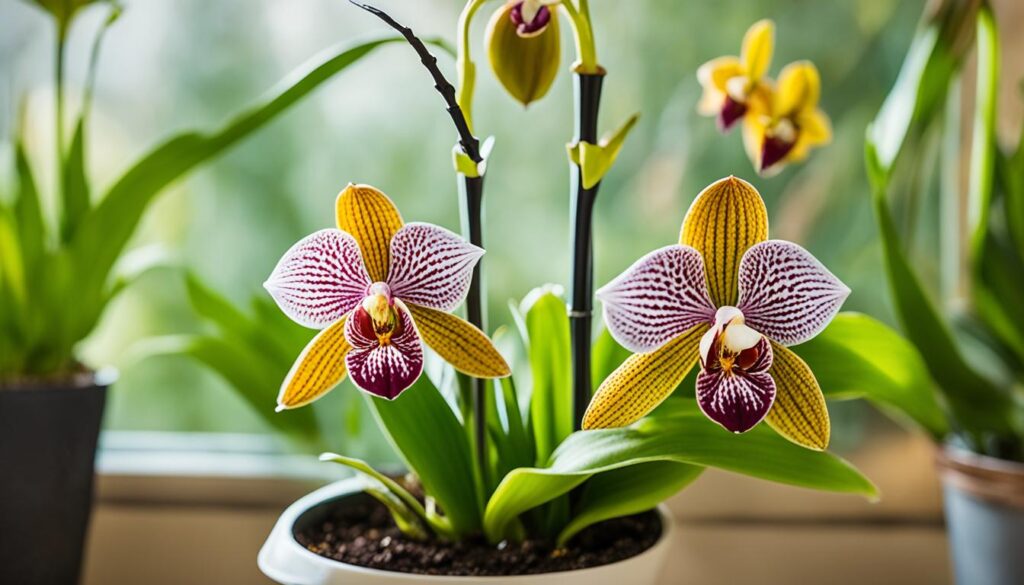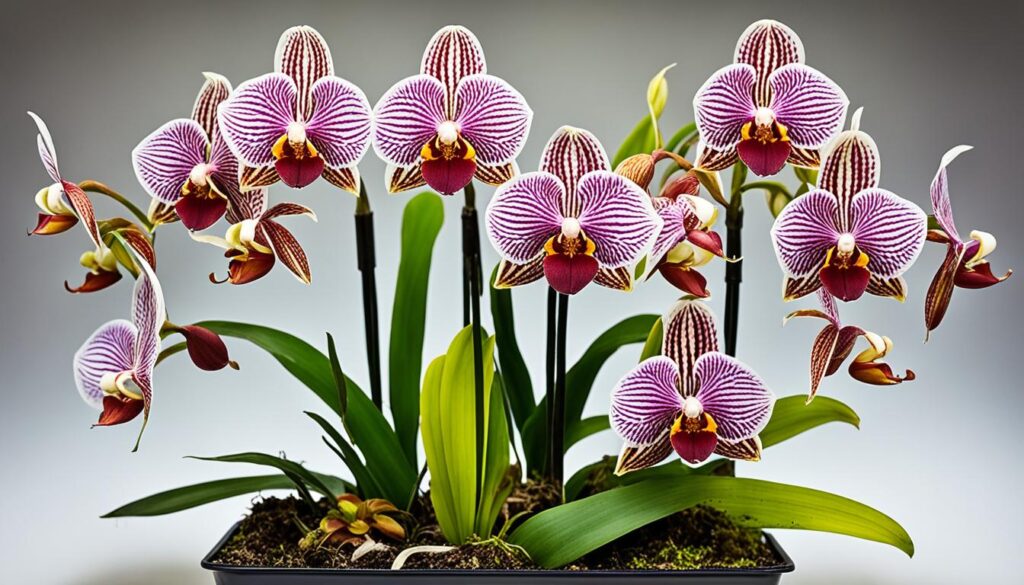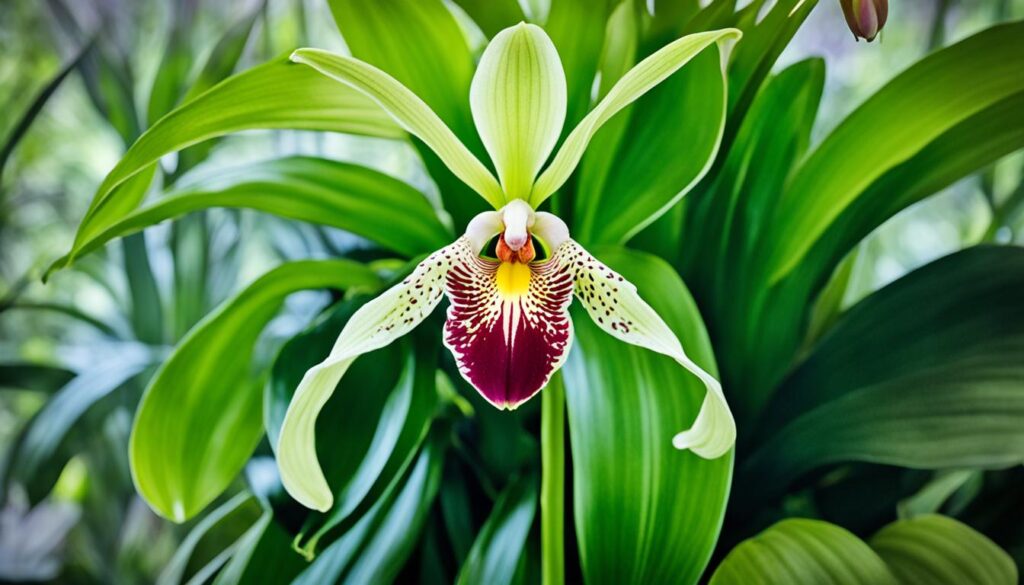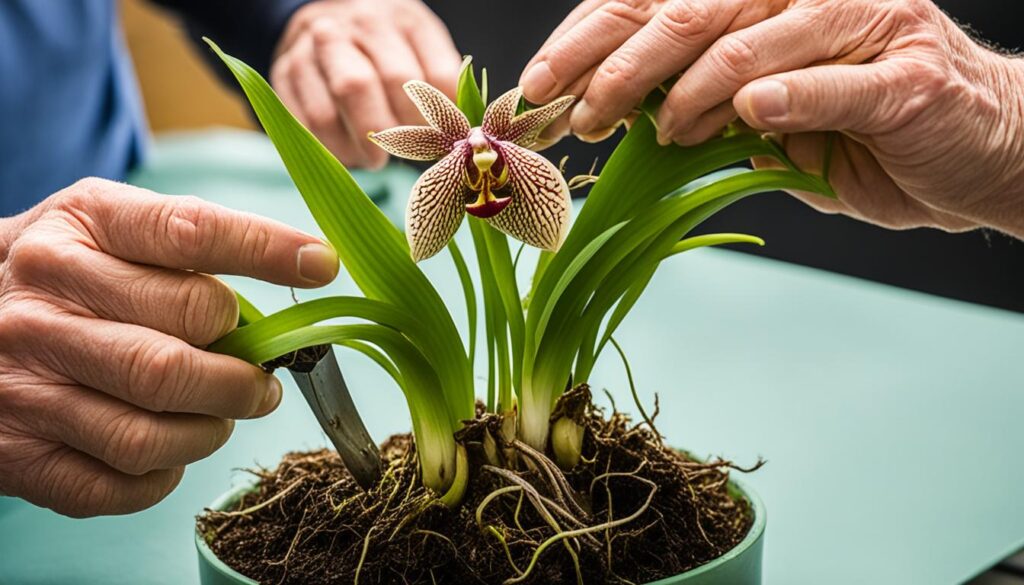Did you know the majestic slipper orchid family boasts over 100 distinct species? Paphiopedilum orchids, the stars of this botanical ensemble, are cherished by collectors for their astonishing beauty and exotic presence.
Quick Facts
| Characteristic | Detail |
|---|---|
| Countries of Origin | Southeast Asia, including India, China, Southeast Asia, and the Pacific Islands |
| Colors | Wide range including greens, browns, purples, and pinks, often with intricate patterns |
| Size | Small to medium, with leaf spans ranging from a few inches to over a foot wide |
| Difficulty To Grow | Moderate; specific humidity and temperature requirements, but adaptable to indoor conditions |
| Bloom Season | Varies by species; many bloom in winter or early spring |
| Light Requirements | Low to medium; prefers bright, indirect light, no direct sunlight |
| Watering Needs | Consistent moisture needed; does not tolerate drying out completely |
| Temperature Range | Depends on species; generally prefers intermediate to warm conditions |
| Potting Medium | Well-draining; a mix of bark, perlite, and sometimes sphagnum moss |
| Propagation Methods | Division of mature plants or by seed (in a lab setting) |
| Common Pests and Diseases | Susceptible to root rot, viral diseases, and pests like spider mites and scale |
| Fragrance | Generally not fragrant, but some species have a mild scent |
| Lifespan/Longevity | Long-lived, with individual plants surviving many years with proper care |
| Conservation Status | Some species are threatened or endangered due to habitat loss and over-collection |
| Unique Features | Slipper-shaped pouches on the flowers, which are used to trap insects for pollination; highly varied leaf patterns and textures |
Known for their unique, slipper-shaped pouches, these orchid varieties have captivated enthusiasts and transformed indoor gardens into spectacular shows.
I’m here to guide you through the world of Paphiopedilum orchids. These slipper orchids are more than just plants; they’re living art forms that can light up any room they grace.
If you’re ready to bring a slice of nature’s splendor into your home, you’ll want to know all about the care and keeping of these stunning flowers.
Let’s dive into the charming realm of slipper orchids and turn your indoor garden into a breathtaking spectacle.
Key Takeaways
- Explore over 100 unique types of Paphiopedilum orchids, each offering its own spectacular show.
- Slipper orchids are not just plants; they’re prized for their unique beauty and are like natural art pieces.
- Discover essential care tips to make your slipper orchids thrive and brighten your indoor spaces.
- Learn to appreciate the diversity of orchid varieties and the enchanting effect they have in home gardens.
- Understand how the right care can turn your Paphiopedilum orchids into showstoppers.
You’ll be Amazed by Paphiopedilum Orchids’ Diversity
Have you ever marveled at the sheer variety of Paphiopedilum species known as lady’s slipper orchids?
Their diversity is boundless, with each hybrid and variation bringing its distinct charm and sophistication.
These beguiling plants are more than just flowers; they’re a study in the artful dance of nature’s creativity.
Take the illustrious Paph Bel Royal ‘Memoria Terry Turner’ AM/AOC, for instance.
It clinched the title of Champion Lady’s Slipper Orchid with its exceptional beauty and form.
But the Bel Royal is just the tip of the iceberg when it comes to the lady’s slipper orchids‘ dazzling diversity.
- From the enchanting deep hues of Paphiopedilum Maudiae to the intricate patterns of Paphiopedilum rothschildianum, there’s an endless tapestry of colors and designs to explore.
- And let’s not forget about the rich textures! Some boast sumptuous, velvety petals while others display waxy surfaces that gleam under the sunlight in your living room.
- Whether you’re a collector or a casual fan, each Paphiopedilum species you add to your indoor garden promises its own unique story and spectacle.
“Venturing into the world of Paphiopedilum is like opening a treasure chest; every orchid you encounter is a gem, shimmering with its distinctive luster.”
But to truly appreciate and nurture these botanical treasures, one must grasp the basics of orchid care.
It’s not just about admiration; it’s about understanding how light, water, and temperature intertwine to foster the perfect bloom.
Knowing when to water, how to mix the right potting concoction, and where to place your alluring plants within your abode will make all the difference.
If you’re excited to dive into this delightfully diverse family of orchids, then let’s journey together through the fascinating world of Paphiopedilum.
From the velvety touch of their petals to the gossamer-like threads that suspend their pollen, these beauties promise to enchant and inspire orchid enthusiasts and novices alike.
How to Provide the Perfect Orchid Care for Your Paphs
As a proud owner of Paphiopedilum, commonly known as lady’s slipper orchids, it is essential to master their care.
Let’s delve into the basics that will ensure your orchids not only survive but thrive, making your growing orchids experience a triumph.
Understanding Paphiopedilum Watering Schedule
When it comes to Paphiopedilum care tips, the watering schedule is non-negotiable. I’ve learned that keeping the soil consistently moist is what these beauties crave.
Overwatering is a sure path to root rot, whereas under-watering will leave them thirsty and hindered.
Implementing a balanced orchid watering schedule guarantees the perfect environment for optimum health and growth of your Paphiopedilum orchids.

Choosing the Right Orchid Potting Mix
Now, let’s talk dirt, or rather, the perfect Orchid potting mix. The right mix does more than just hold your orchid; it breathes life into the roots.
A fast-draining mix that not only retains moisture but also allows excess water to escape is what your Paphs need. The key here?
A mix that balances airflow and moisture, because remember – no one likes wet feet for too long, not even your Paphiopedilum orchids.
Paphiopedilum Care Tips: Light and Temperature
Shining a light on yet another aspect of Paphiopedilum care, literal light and the warmth that sustains them.
Moderate lighting replicates the dappled shade of their natural habitat and encourages photosynthesis without the scorch of direct sunlight.
Pair that with intermediate temperatures, and you’ll have the perfect backdrop for a flourishing display of lady’s slipper orchids.
In my home, this mimicking of tropical Asian climes has been key to seeing my Paphiopedilum bloom in all their glory.
Uncovering the Mysteries of Paphiopedilum Species
I’ve always been intrigued by the rich tapestry of history that envelops the Paphiopedilum species, a genus deeply rooted in the mystique of ancient tales.
With their unique allure, these species stand as a testament to the natural world’s endless capacity for beauty, evoking the legend of Aphrodite herself.
It’s as if each petal and pouch of these Paphiopedilum hybrids narrates a chapter from a story woven by the gods.
Imagine a collection of orchids so varied that they capture the essence of a mythology.
The Paphiopedilum genus, hailing from Eastern Asia, encompasses a myriad of forms and hues, all telling stories of their own.
It’s not just their names that fascinate me but the spellbinding beauty they possess, a beauty hailed to befit the goddess of love.

My passion leads me to dig deeper into the natural splendor of these plants.
And I must say, to see a Paphiopedilum in bloom is to witness nature’s own artistry in real-time.
Yet, what captures my heart most is not just their aesthetic appeal but the incredible diversity found within the genus.
It’s like each Paphiopedilum hybrid whispers a different secret, a different piece of orchid lore that’s just waiting to be unveiled.
Perhaps my favorite aspect, though, is the conversation these orchids inspire among fellow enthusiasts.
There’s something special about sharing knowledge and stories about these botanical wonders, akin to passing down folklore across generations.
Each gardener I meet seems to have their own unique experience to share, making the journey of cultivating Paphiopedilum species even more enriching.
- Perpetual allure of Paphiopedilum’s colors and shapes
- Connection to the mythical birthplace of Aphrodite
- Diverse, storied history of each Paphiopedilum hybrid
- Camaraderie and shared passion among orchid growers
And so, my journey with Paphiopedilum orchids continues, a journey of unending exploration and amazement.
With each new species I encounter, I find myself a step closer to uncovering the full extent of the mysteries these extraordinary plants hold.
Become an Expert at Growing Orchids at Home
The journey towards mastering Paphiopedilum care at home starts with embracing the dual spirits of patience and precision.
In my quest to cultivate these captivating plants, I’ve discovered that there is a rhythm to tending to these exotic beauties which, when understood, can lead to immensely rewarding orchid care.
Propagating Your Paphiopedilum Orchids
Propagating orchids, especially Paphiopedilums, is an art form that requires a careful touch.
While it may not be as simple as sowing seeds or dividing roots, the process unveils a magical dimension of plant biology.
I’ve diligently followed the guidance of seasoned orchid growers and witnessed my collection flourish.
Remember, the successful propagation of these orchids can mean a lifetime of lush, spectacular blooms.

Dealing with Common Orchid Pests and Diseases
Even the most thriving orchid gardens can face occasional setbacks from pests and diseases.
In my experience, a keen eye and a timely response are the best defenses. From scale insects to fungal spots, common orchid pests need to be recognized early.
I’ve learned that the best approach is to maintain rigorous hygiene and use eco-friendly pest control measures, ensuring the longevity and vitality of my orchids.
Repotting: When and How
Repotting orchids can seem like navigating a minefield for the uninitiated; however, it’s a critical component of Paphiopedilum care.
Orchids relish a refresh, and my hands-on experience has taught me to repot before the mix breaks down, usually every couple of years.
This avoids the common orchid ailment of root rot, which can easily cripple a plant.
Here’s a comparative table showing when to repot different types of orchids, including Paphiopedilum:
| Orchid Type | When to Repot | Signs It’s Time |
|---|---|---|
| Paphiopedilum | Every 1-2 years | Roots outgrowing the pot, slowing growth, or medium breakdown |
| Phalaenopsis | Every 1-3 years | Soggy potting medium or visible decline in health |
| Cattleya | After blooming season | Crowded conditions or pseudobulbs touching the pot’s edge |
| Oncidium | Every 2 years | Bulbs multiplying and pushing against the pot’s sides |
Following the practices outlined above has been instrumental in not just sustaining but truly elevating the care of my orchids.
It’s a journey that’s both challenging and intensely satisfying, one where the blooms are a testament to the devotion poured into these remarkable plants.
Paphiopedilum Orchids: Elevating Your Indoor Garden
Imagine stepping into your living room, where a lush tapestry of green leaves interspersed with vibrant blooms greets your eyes.
This is the transformative beauty that growing orchids, particularly Paphiopedilum orchids, can add to your indoor garden.
Known for their striking and intricate flowers, Paphiopedilum orchids can indeed take your home decor to the next level, infusing it with an exotic and tropical essence reminiscent of faraway rainforests.
The journey to nurturing these exquisite plants within the comfort of your home begins with an understanding of their specific needs.
I firmly believe that anyone, regardless of their experience with orchids, can cultivate a breathtaking indoor garden.
With a touch of mindfulness and the right care, you can watch these slipper orchids thrive and unfold their splendor day after day.

Here are some essentials for helping your Paphiopedilum orchids reach their full potential:
- Proper watering techniques to maintain consistent moisture
- Choosing an orchid-friendly potting mix that allows roots to breathe
- Providing the right balance of light to replicate their natural, dappled environment
Let’s take a closer look at how to integrate Paphiopedilum orchids into your indoor garden design:
| Area of Indoor Garden | Ideal Orchid Placement | Benefits to Your Space |
|---|---|---|
| Lively Living Rooms | Near east-facing windows | Adds a touch of sophistication and conversation piece |
| Serene Bedrooms | On side tables or shelves | Promotes a calming environment and improves air quality |
| Inviting Hallways | Along the corridor in stylish orchid pots | Creates a welcoming atmosphere for guests |
It’s a joy to delve into the world of Paphiopedilum orchids, discover their peculiarities, such as their long-lasting flowers and distinctive shapes.
By inviting these living works of art into your space, you’ll not only be growing orchids; you’ll be enriching your life with natural beauty and a sense of accomplishment.
Start today, and elevate your indoor garden into an enchanting, orchid-filled sanctuary.
Create the Ideal Environment for Your Slipper Orchid’s Spectacular Show
As an enthusiast of the Paphiopedilum’s marvelous blooms, I’ve discovered that providing the right conditions can make all the difference.
Delicate and yet resilient, these orchids ask for a bit of attention, specifically in controlling their humidity and air circulation.
Let’s dive into the essentials of Paphiopedilum care to ensure your orchids flourish.
Maintaining Humidity for Paphiopedilum Orchids
To mimic the rainforest vibe that Paphiopedilum orchids adore, managing humidity for orchids becomes a part of our daily care routine.
Whether you choose to set up a humidifier or place water trays around them, ensuring the air is moist will promote vibrant growth and those desired lush blooms.
Remember, it’s not just about cranking up the humidity. It’s about creating an environment where your Paphiopedilum can feel right at home.

The Importance of Air Circulation for Orchid Growth
Equally important to Paphiopedilum care is facilitating air circulation. These beauties need fresh air to prevent disease and enable strong growth.
A gentle fan or an open window can work wonders, but no drafty spots, please! The right balance of air movement helps to prevent pest infestations and fungal problems, which can quickly dampen a Paphiopedilum’s show.
By combining air circulation with the right humidity levels, your slipper orchids are set to put on an unforgettable display.
- Use a humidifier for consistent moisture.
- Place water trays for passive humidity.
- Misting helps, but don’t overdo it.
- Keep air moving with a fan or ventilation.
Following these Paphiopedilum care tips ensures that your orchids won’t just survive; they’ll thrive.
Watching your slipper orchids unfurl their stunning blossoms is a rewarding experience, showing that your dedication to creating the ideal environment pays off in spectacular ways.
From Novice to Pro: The Ultimate Paphiopedilum Care Guide
Embarking on the splendid journey with Paphiopedilum orchids? You’re in for a treat!
As someone who’s watched countless slipper orchids flourish under my care, I’m here to walk you through the essential orchid care practices.
No need to get tangled in technical jargon. Let’s dive into a down-to-earth, comprehensive Paphiopedilum care guide, sprinkled with handy orchid growing tips to transition you from a greenhorn to a green thumb.

- First, the basics: Watering your orchids can seem tricky, but it doesn’t have to be. Stick to a schedule that keeps the soil slightly moist. Trust me, your Paphiopedilums will show their gratitude with vibrancy.
- Next up, the potting mix. This is like choosing a home for your orchids. Get a well-draining mix; one that imitates the cozy, bark-laden floors of tropical forests where these beauties originate.
- Don’t forget about the ambiance. Light is like an orchid’s best friend – not too harsh, but just enough to mimic the soft sunlight filtering through tree canopies.
But I’m not just throwing tips at you from the sidelines. I’ve been in the greenhouse, hands in the dirt, nurturing these orchids from delicate starts to award-winners.
I’ve seen the bright, unexpected blooms that make a grower’s heart skip a beat.
And I tell you, there’s nothing quite like the satisfaction that comes from getting orchid care just right.
So, yes, whether you’re just starting out or you’re looking to level up your slipper orchid game, keep this guide close.
I promise, with a bit of patience and practice, you’ll see your Paphiopedilums transform from humble starts into stunning displays.
And isn’t that the kind of spectacular growth we’re all hoping for?
Conclusion
The universe of Paphiopedilum orchids is a tapestry of vibrant colors and intriguing shapes, weaving a rich tale that dates back to ancient times.
These slipper orchids present gardeners with a delightful undertaking that is both challenging and rewarding.
By adhering to a quality orchid care guide and embracing the nuances of growing orchids, you can take pride in the lush spectacle that unfolds within your living space.
The splendor of a blooming Paphiopedilum is more than a visual treat—it’s a testament to the dedication and tenderness invested in each petal.
My personal journey with these orchids has taught me the essence of patience and precision.
From selecting the right substrate to ensuring the perfect humidity level, every detail counts towards the ultimate success of these enchanting plants.
As I watch my home come to life with the natural allure of these gorgeous blooms, I am reminded again why the Paphiopedilum species holds such a special place in the hearts of hobbyists and expert gardeners alike.
Whether you’re entranced by the dance of a new leaf or cradling the weight of a fresh flower spike, remember that the path to cultivating Paphiopedilum orchids is one of perpetual learning and joy.
Keep your orchid care guide close and allow your passion for these natural wonders to propel you towards a flourishing indoor garden that is nothing short of a spectacular show.


Leave a Reply